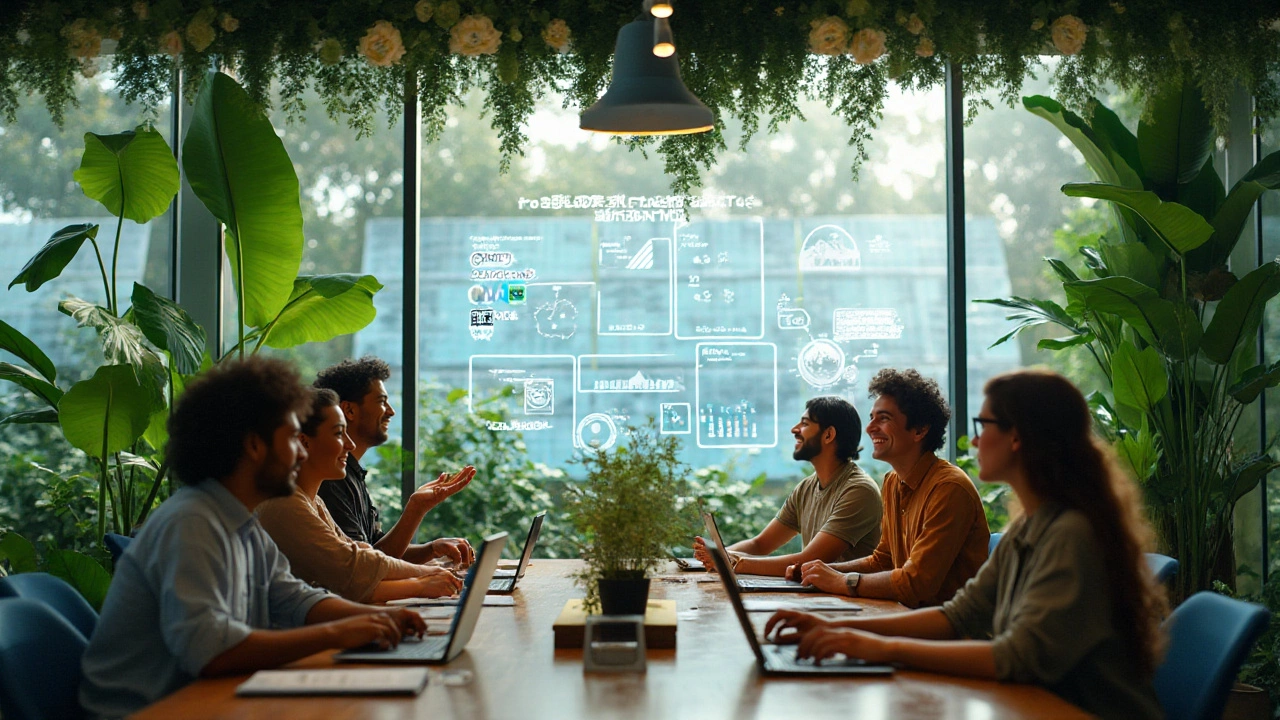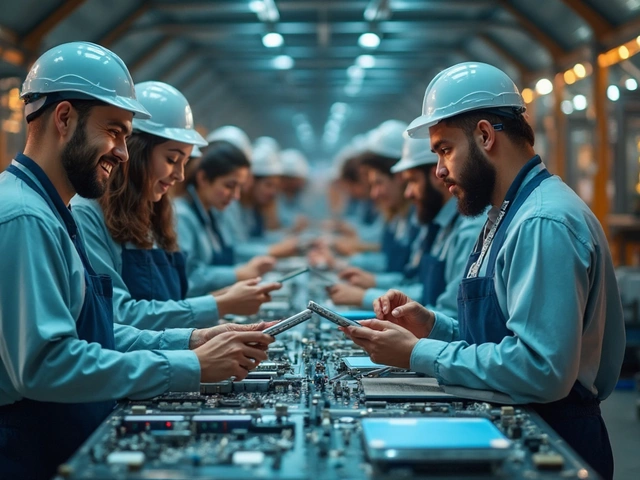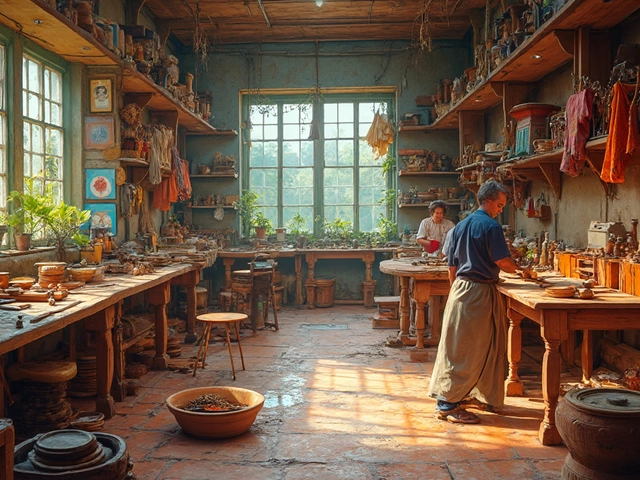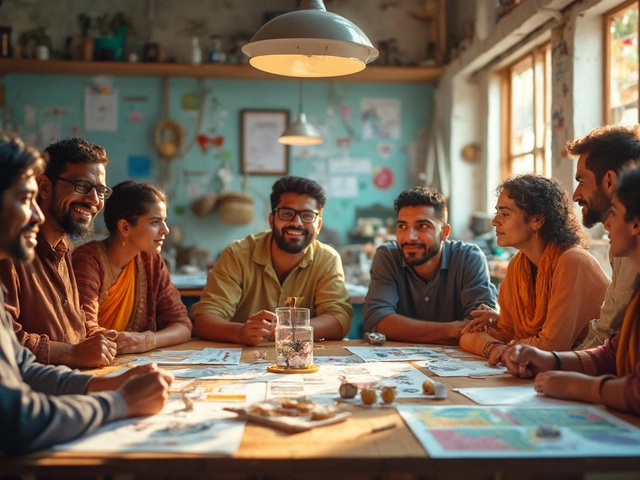As we venture into 2025, the manufacturing industry is witnessing a seismic shift towards sustainability. This change is driven by growing consumer awareness, strict regulatory standards, and a global pledge to combat climate change. Companies are increasingly turning to sustainable manufacturing techniques, which not only minimize environmental harm but also leverage new tech to streamline operations.
The narrative is no longer just about reducing the carbon footprint; instead, it's about creating systems that are resilient and adaptable. From renewable energy integration to using recycled materials, these practices are becoming cornerstone principles for manufacturers aiming for long-term success. This transformation is opening up a world of opportunities for entrepreneurs and investors eager to step into a future-centric field.
- Current Trends in Sustainable Manufacturing
- Innovative Technologies Shaping the Sector
- Key Players and Start-Ups to Watch
- Challenges and Strategies for Growth
- Market Opportunities and Investment
- Impact of Sustainability on Profit Margins
Current Trends in Sustainable Manufacturing
In recent years, the rise of sustainable manufacturing has not only captured the attention of environmental enthusiasts but has also become a strategic imperative for industries across the globe. Companies, both large and small, are acknowledging the vast benefits that come with integrating eco-friendly practices into their manufacturing processes. A substantial driving force behind this trend is the heightened consumer consciousness around environmental conservation. Modern consumers prefer to align themselves with brands that exhibit genuine commitments to sustainable methodologies. From sourcing raw materials responsibly to adopting energy-efficient production techniques, these efforts highlight a significant movement toward ecological mindfulness.
An exciting development within this landscape is the adoption of the circular economy model. This approach emphasizes closed-loop product lifecycles, where waste is minimized by keeping materials in use for as long as possible. By adopting this model, businesses not only reduce their environmental footprint but also unlock financial savings through resource efficiency. For instance, many industries are increasingly turning to recycled plastics and metals to produce high-quality goods. This shift not only reduces dependency on virgin materials but also supports a more sustainable ecosystem. Moreover, governments around the world are incentivizing such practices by offering tax breaks and subsidies to organizations that prioritize the reuse and repurposing of materials.
An influential voice in the sector, Paul Polman, former CEO of Unilever, has often emphasized the importance of sustainability in manufacturing.
"The race to the top is clearly on. In the pursuit of growth, cutting costs, and delivering sustainable outcomes, businesses are learning that aligning economic and environmental agendas is not just possible, but profitable."His perspective resonates deeply within the industry, reiterating that embracing sustainability is no longer optional but essential for sustained success.
Data indicates that the renewable energy sector is witnessing exponential growth and innovation. According to recent studies, the renewable energy market is projected to reach approximately $2 trillion by 2030. Within this domain, solar and wind energy are particularly noteworthy, as both have seen significant technological advancements and cost reductions over the past decade. Manufacturers are leveraging these energy sources to power their production lines, thereby drastically reducing carbon emissions. This sustainability approach to manufacturing industry growth not only caters to environmental goals but also offers manufacturers long-term cost-saving benefits, making it a win-win scenario.
Amidst these shifts, digitization has emerged as a key trend within sustainable manufacturing. The integration of digital technologies, such as the Internet of Things (IoT), artificial intelligence, and blockchain, has revolutionized traditional manufacturing processes. By employing these technologies, businesses can monitor and optimize energy use, reduce waste, and elevate their sustainability credentials. For instance, IoT devices can provide real-time data on energy consumption across a factory, enabling precise adjustments to ensure optimal efficiency. Similarly, AI-driven predictive maintenance systems help in identifying machine malfunctions before they occur, thus minimizing downtimes and reducing waste.
All these factors culminate in a transformative journey for manufacturers worldwide. With ongoing support from government policies, evolving consumer preferences, and technological advancements, the momentum towards sustainable practices is only expected to strengthen. This movement not only paves the way for a healthier planet but also redefines how businesses perceive profitability and growth. In this ever-evolving landscape, companies that ride the wave of sustainable manufacturing will position themselves as trailblazers for the future, reaping the rewards of their proactive efforts in the rapidly expanding industry trends sector.
Innovative Technologies Shaping the Sector
Innovation is steering the wheel of transformation in the manufacturing industry, with sustainability leading the charge. The rise of advanced technologies like artificial intelligence and machine learning is enabling companies to adopt more efficient, less wasteful manufacturing processes. These technologies are integral in predictive maintenance, real-time monitoring, and managing supply chains more effectively. Automated systems are reducing human error and increasing productivity by leaps and bounds, making operations smoother and less reliant on manual oversight. Equally important, they are helping in significant cost reductions, which can be redirected into enhancing product quality and expanding business horizons.
Another groundbreaking stride in the industry is the incorporation of the Internet of Things (IoT). IoT innovations are facilitating data exchange between machinery and IT systems, driving the move toward 'smart factories' where every machine is interconnected. This connectivity allows not only for automation but also for more comprehensive data analytics. Companies can assess performance metrics in real-time, make informed decisions rapidly, and foresee potential snags before they become costly setbacks. For example, connecting machinery with IoT can lead companies to a predictive approach to maintenance rather than reactive, which can decrease downtime significantly.
Additive manufacturing, otherwise known as 3D printing, has made its mark as a revolutionary player. This technology allows for rapid prototyping, empowering manufacturers to experiment with designs without incurring high costs or wasting resources. It has also made mass customization feasible, providing a competitive edge for companies looking to cater to niche markets with specific demands. The materials used in 3D printing are not solely restricted to plastics, as advances are enabling the use of metals and biomaterials, which resonates well with the push for sustainability. Companies are finding ways to leverage this technology to create lighter, stronger, and more efficient products.
As R. Buckminster Fuller once aptly noted, "Pollution is nothing but the resources we are not harvesting." This reflects today's mindset shift towards resource efficiency through innovation.
Biodegradable and renewable materials are gaining traction too. The integration of eco-friendly materials into the manufacturing process is an irreplaceable part of the sustainable equation. There has been a surge in research and development focused on materials like bioplastics, which can significantly reduce the environmental footprint of products. Such materials are not only sustainable but have the potential to offer superior properties compared to traditional counterparts, enhancing both durability and performance.
Robotics and automation are not new players but are taking on new roles in modern manufacturing floors. Robots, equipped with machine learning capabilities, are not just carrying out repetitive tasks but can adapt to various roles, such as quality control and even error correction. This versatility is key in maintaining flexibility in manufacturing environments, especially as consumer demands continue to evolve rapidly. Robo-advisors or decision-support bots are assisting managers in crunching the data and offering insights that would otherwise take human experts weeks to compile.
The shift towards renewable energy is another crucial factor reshaping the sector. Solar panels, wind turbines, and other renewable energies are being integrated into production facilities. By utilizing clean energy, companies can decrease their dependence on non-renewable resources and lower their carbon emissions. Not just beneficial for the environment, it's cost-effective in the long run due to the decreasing costs of renewable installations. This contributes greatly towards achieving energy independence - an appealing goal for many companies seeking to buffer against future energy price spikes.

Key Players and Start-Ups to Watch
The world of sustainable manufacturing is bustling with trailblazers who are setting benchmarks that others aspire to match. These key players are revolutionizing traditional practices, infusing them with innovative technologies and eco-conscious strategies. Leading the charge is Tesla, whose Gigafactories epitomize the blend of massive production capacity with minimal environmental impact. By building energy-efficient facilities powered by renewable energy sources, Tesla has set an audacious model for automotive manufacturing.
Another noteworthy name is Patagonia, a pioneer in producing durable goods with a philosophy rooted in environmental stewardship. The company emphasizes the importance of recycled materials in its production line, making strides in reducing waste significantly. But it's not just the giants making waves. Many nimble start-ups are stepping into the limelight with groundbreaking approaches. One such start-up is Northvolt, a Swedish battery developer, striving to create the world’s greenest battery. Their commitment to powering a future free from fossil fuels is impressive in both ambition and execution.
"The best way to predict the future is to invent it." – Alan Kay
Start-ups like Loop Industries have taken this to heart by developing a revolutionary process to transform waste plastic into virgin-quality PET resin. As the demand for sustainable practices grows, these companies provide a glimpse into the infinite possibilities that await in the industry.
The sector is also ripe with investors keen to back ethical enterprises. Start-ups such as ECOllective, which focuses on biodegradable packaging, exemplify the spirit of innovation sprinkled with social responsibility. This initiative is an exemplary success story that highlights the potential lying in sustainable packaging solutions.
In terms of numbers, the sustainable manufacturing market is poised for a surge with an estimated compound annual growth rate of over 9% in the next decade. With Asia-Pacific leading the charge, followed by North America, the spotlight is now on regions flipping traditional manufacturing paradigms head-over. As the winds of change sweep across the globe, these players at the helm of the revolution are geared to chart new courses and reach unchartered growth territories, turning sustainability from a future ideal into a current reality. For entrepreneurs and investors eyeing the industry, it’s vital to keep an eye on such torchbearers paving the way toward a greener and more profitable future.
Challenges and Strategies for Growth
The path to sustainable manufacturing might seem appealing but it is laden with distinct challenges and opportunities. One major barrier is the initial cost of setting up eco-friendly systems. Transitioning from traditional methods to more sustainable options often demands substantial capital investment. This cost encompasses not only the physical infrastructure but also training employees to adapt to the new technologies. Without a doubt, companies might find themselves hesitant to make such a leap, especially when profitability is uncertain. Yet, as these methods mature, they promise reduced operational expenses through energy efficiency and resource conservation. It's essential to consider these long-term savings when evaluating the cost-benefit aspect.
Moreover, another pressing challenge is the preservation of product quality while implementing sustainable processes. Consumers today expect not only green products but also high-end effectiveness. Striking a balance between these can be daunting, as altering manufacturing processes often affects product formulation and durability. An emphasis on research and development is paramount to innovate without compromising on quality. Harmonizing advanced technologies with sustainable materials could provide considerable leverage.
Global logistics and supply chain modifications further complicate the process. Most sustainable manufacturers prefer local sourcing to minimize carbon emissions, which can conflict with global supply chain strategies that prioritize cost-efficiency. Thus, creating an equilibrium where logistics and sustainability align is critical. Experts are predicting that frameworks focusing on regional manufacturing hubs could be a solution, as they can reduce environmental impact and enhance adaptive capacity.
Another significant challenge is obtaining support from stakeholders. Convincing investors and partners about the far-reaching benefits of sustainable practices might not always be straightforward. To mitigate this, having a well-drawn plan that clearly articulates potential returns - both environmentally and financially - is indispensable. George Mason University highlights the dual benefit of such transformations: "Sustainable innovations drive not only ecological welfare but also market resilience." Establishing transparent communication channels with stakeholders aids in building trust and consensus.
Despite these challenges, there are strategic imperatives that can catalyze growth in this sector. First and foremost, establishing a robust framework of regulations and incentives can propel businesses to integrate sustainable models. Governments around the world are realizing this and offering tax rebates and subsidies for companies who meet specified green metrics. Adopting a proactive approach in this regard can provide a competitive edge to those who act early.
| Year | Global Sustainable Investment (in Billion USD) |
|---|---|
| 2021 | 35 |
| 2022 | 40 |
| 2023 | 47 |
| 2024 | 53 |
Additionally, fostering collaborations is critical. Cross-industry partnerships amplify innovation, while joint ventures might offer shared risk and more comprehensive market coverage. Finally, staying agile and informed about emerging trends within the sustainable manufacturing landscape can reveal untapped opportunities. Being at the forefront of technological evolution enables businesses to pivot effectively and leverage advancements.

Market Opportunities and Investment
The surge in interest around sustainable manufacturing presents burgeoning opportunities for businesses and investors alike. As consumers increasingly demand eco-friendly products, companies that prioritize sustainable practices stand to benefit from a growing market share. This shift is particularly prominent in sectors such as renewable energy, recycled materials, and energy-efficient technologies. Innovative start-ups within these areas are receiving sizable amounts of investment, drawing attention to their potential for profitable returns.
Investors are keenly observing trends in industry growth, understanding that early involvement can lead to substantial financial benefits. Key industries such as electric vehicles, waste-to-energy systems, and sustainable agriculture are at the forefront. For entrepreneurs and established firms, entering these markets with unique propositions could lead to rapid scaling. Notably, the electric vehicle market alone is projected to grow at a compound annual growth rate of 21.7% over the next few years, presenting an inviting prospect for those eager to innovate.
Fostering relationships between traditional manufacturers and tech innovators can yield novel products and processes that support environmental goals. For instance, partnerships that integrate AI for efficiency improvements or utilize blockchain for transparent supply chains are becoming highly sought after. Such collaborations can offer competitive advantages in an era where efficiency and transparency are prized.
"Investing in sustainable practices isn't just good for the planet—it’s smart business," says Bill Gates. In his extensive philanthropic work, Gates notes the tangible financial incentives for companies that lead the way in sustainability.
In addition, government incentives and regulatory pressures are catalyzing investment in sustainable industries. Tax credits, grants, and subsidies are often available to firms willing to adopt green practices, significantly reducing the upfront costs of transitioning. These financial levers can make the initial move into sustainable manufacturing more appealing and economically viable.
A strategic roadmap for tapping into these market opportunities involves conducting market research to identify gaps and consumer needs, developing business models that prioritize sustainability, and actively seeking out partnerships and funding. Successful firms often employ a combination of innovative product development, agile marketing strategies, and stringent sustainability benchmarks to capture and retain market interest.
The landscape of sustainable manufacturing is expanding, driven by technological advancements and a fundamental shift in consumer values. For those poised to invest wisely, there lies a promising horizon of endless possibilities. Understanding the dynamic interplay of these factors is crucial for anyone looking to thrive in this rapidly evolving industry. The pathway to capitalizing on these opportunities requires a blend of forward-thinking strategies, financial acumen, and a commitment to genuine sustainability.
Impact of Sustainability on Profit Margins
Sustainability isn't just about conscience—it increasingly makes sound business sense. Companies have started to realize the financial gains that come from embracing eco-friendly practices, and the impact on profit margins is quite significant. By reducing waste and improving energy efficiency, businesses not only cut costs but also appeal to environmentally-conscious consumers, resulting in increased market share. For instance, a report by McKinsey highlights that more than 92% of consumers in the U.S. are more likely to trust brands that demonstrate a commitment to the environment. This trust is crucial as it directly translates into consumer loyalty and, consequently, higher sales figures.
Manufacturing industry growth is increasingly tied to sustainability initiatives. With the implementation of renewable energy sources, businesses can significantly lower their operational costs. Solar and wind energy installations, though initially pricey, lead to remarkable long-term savings. According to the International Renewable Energy Agency (IRENA), the cost of solar energy has fallen by around 82% since 2010. These savings start improving profit margins within a few years, making the upfront investment worthwhile. Moreover, incentives and tax rebates from governments can further ease the burden of initial investments.
There's also a strategic advantage in creating products that align with sustainable values. By differentiating themselves through green manufacturing processes, companies can charge a premium for their products. This appeals to a niche market segment that isn't just looking for quality but also for products that reflect their personal values. The ability to brand products as environmentally friendly nurtures a loyal customer base, often willing to pay more for products they perceive as ethical and responsible.
However, the road to a fully sustainable manufacturing model isn't without its challenges. Initial costs can be daunting, and the transition may involve a learning curve. Businesses may need to recalibrate their current systems, resulting in temporary disruptions. Yet, those who brave these initial hurdles find the outcomes rewarding. A 2022 study by Deloitte found that companies prioritizing sustainability experienced faster recovery from the COVID-19 downturn and surged ahead as consumer preferences shifted toward ethical consumption.
"Sustainability isn't only good for the planet; it's a strategic imperative," says Paul Polman, former CEO of Unilever. "Companies that integrate environmental, social, and governance (ESG) factors into their core strategies outperform their peers."
The adoption of sustainable manufacturing has another financial implication: the reduction in regulatory risks. As governments worldwide tighten environmental regulations, companies that have already implemented sustainable practices face fewer compliance issues and fines. This foresight protects their profit margins from unexpected regulatory expenses and offers a competitive edge over less proactive rivals.
The potential impact on profit can also be quantified by examining savings in waste management and material costs. Utilizing recycled materials and reducing packaging waste contribute directly to lowering production expenses. Such practices not only improve margins but also resonate with customers. This alignment can enhance brand image and drive profits further, confirming the wisdom of investing in sustainable operations. As businesses align their sustainability goals with profit motives, they can unlock unprecedented growth opportunities and ensure their long-term success.






